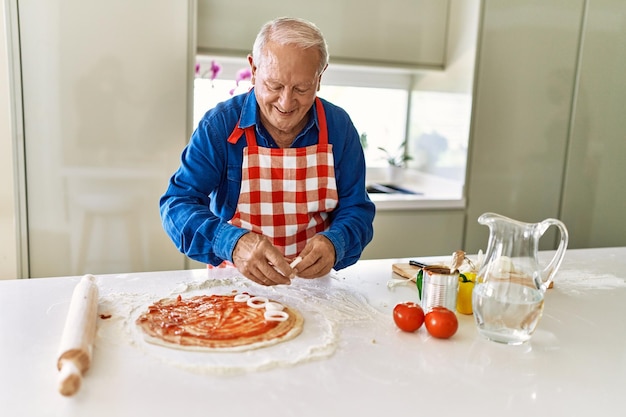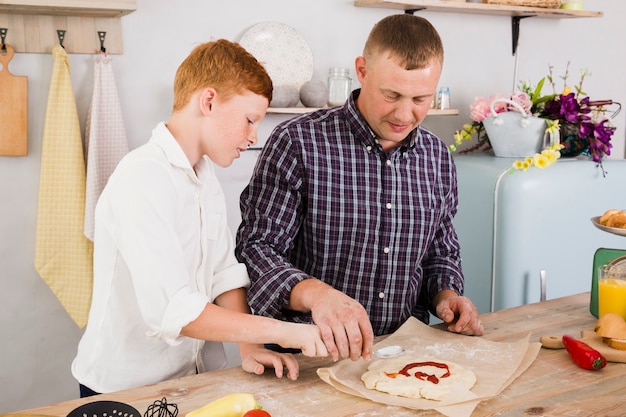(Part 1) Your Oven: The Heart of the Operation

Oven Types: Understanding the Players
Every oven has its own personality, and each type brings its own strengths to the table.- Gas Ovens: These ovens are known for their even heating, giving you a consistently cooked pizza. They also pack a punch when it comes to temperature, which is fantastic for achieving that char-grilled crust we all crave. Just remember to give them a little extra time to preheat, as they can take a bit longer to reach the desired temperature.
- Electric Ovens: Electric ovens are generally more predictable when it comes to temperature control, offering a bit more consistency. They're great for beginners, but might not achieve the same level of char as a gas oven.
- Pizza Ovens: Now, if you're serious about your pizza game, a dedicated pizza oven is the ultimate weapon. Imagine those wood-fired pizzas you get at your favourite pizzeria? That's what these ovens are all about. They reach incredibly high temperatures, giving you that authentic, smoky flavour and a super crispy crust. But let's be realistic – they're not exactly a budget-friendly option.
Calibrating Your Oven: Getting to Know its Temperature
Temperature is crucial for pizza baking, and it's worth checking whether your oven is running true to its dial. It's like making sure your car's speedometer is accurate. If you're not sure, a trusty oven thermometer is your best friend. If your oven runs hot or cold, you'll need to adjust your baking times accordingly.Preheating is Key: A Warm Welcome for Your Pizza
No matter what type of oven you're using, preheating is a must. It's like giving your oven a warm welcome, allowing it to reach the ideal temperature and create a consistent heat for baking. Think of it as preparing the stage for your pizza masterpiece. A good rule of thumb is to preheat your oven for at least 15 minutes before you even think about tossing your pizza in.(Part 2) Pizza Dough: The Foundation of a Great Pie

The Importance of Fresh Dough: A Flavorful Journey
You can always use store-bought dough, but trust me, nothing beats the flavour and texture of fresh, homemade dough. It's like the difference between a mass-produced cookie and a homemade one – there's a depth of flavour and satisfaction you just can't replicate. However, if you're short on time, don't worry, a good quality dough from your local supermarket or pizzeria will still deliver a delicious pizza.Choosing Your Flour: The Building Blocks of Texture
Flour is the foundation of your dough, and the type you choose will influence the texture of your final pizza.- High-Protein Flour (00 Flour): This flour is a favourite for pizza dough. It's packed with protein, which means it produces a strong gluten network that results in a chewy, elastic crust. Think of it as the athlete of the flour world, giving your pizza a strong, resilient texture.
- All-Purpose Flour: This is a good all-rounder for everyday pizza. It's a bit more versatile than 00 flour and produces a decent crust, although it might not be as chewy. It's like the reliable friend of the flour world, offering a good balance of flavour and texture.
Proper Kneading: The Secret to a Happy Dough
Kneading is like giving your dough a good massage. It's crucial for developing the gluten in the dough, creating a smooth, elastic texture that's not too sticky or too dry. Imagine kneading as a dance between your hands and the dough, allowing the gluten to develop and create the perfect texture for your pizza.(Part 3) pizza toppings: The Flavour Symphony

Classic Toppings: The Timeless Staples
Let's start with the classics, the familiar faces of the pizza world.- Tomato Sauce: The base of a traditional pizza, tomato sauce is the conductor of this culinary orchestra, bringing all the other flavours together. It adds a tangy sweetness that perfectly complements the other ingredients.
- Cheese: Mozzarella is the classic choice, melting beautifully and providing a creamy, stretchy texture. But don't be afraid to explore other cheeses like cheddar, provolone, or even goat cheese for a unique twist.
- Pepperoni: A timeless favourite, pepperoni adds a salty, spicy kick to any pizza, bringing a punch of flavour to your creation.
- Mushrooms: From earthy portobellos to delicate shiitakes, mushrooms bring a wonderful umami depth to your pizza, adding a complex, satisfying flavour.
Beyond the Classics: Exploring New Flavour Territories
Don't limit yourself to the classics! The world of pizza toppings is vast and diverse, ready for you to explore.- Seafood: Grilled prawns, smoked salmon, or even anchovies can add a delightful seafood twist to your pizza.
- Vegetables: Roasted peppers, artichoke hearts, caramelized onions, and spinach are all delicious options, adding a burst of colour and freshness to your pizza.
- Meats: Add some protein with sausage, bacon, or even a thinly sliced steak.
(Part 4) Building Your Pizza: A Work of Art
You've got your dough, your toppings, and now it's time to build your pizza. This is where your culinary creativity shines, transforming your ingredients into a masterpiece of flavour.The Pizza Stone: A Secret Weapon for a Crispy Crust
A pizza stone is a valuable tool for achieving that perfect crispy crust. It absorbs heat and distributes it evenly, ensuring a consistent bake. If you don't have a pizza stone, you can use a baking sheet, but a pizza stone will definitely take your pizza to the next level.Stretching the Dough: A Gentle Touch for the Perfect Base
The key to a good pizza base is a perfectly stretched dough. Use your fingertips to gently press the dough out, working from the centre outwards. Avoid stretching the dough too thin, as it might tear. Imagine you're gently coaxing the dough into its desired shape, creating a base that's both strong and flexible.Adding the Sauce: A Thin Layer of Flavour
A thin layer of sauce is all you need. You don't want to drown your toppings in sauce. Think of the sauce as a canvas for your toppings, allowing their flavours to shine.Layering the Toppings: A Symphony of Flavours
Remember, less is more when it comes to toppings. Too many toppings will weigh down the crust and prevent it from cooking evenly. Think of it as a balanced orchestra, where each topping plays its part in harmony.(Part 5) Pizza Baking Times: The Crux of the Matter
Now we're at the heart of the matter: baking times. The exact cooking time will vary depending on your oven, the type of pizza, and the thickness of the crust. It's like baking a cake – each recipe has its own specific timing.General Guidelines: A Starting Point for Baking Success
- Thin Crust: Thin crust pizzas tend to bake faster, typically around 8-12 minutes at 450-500°F (232-260°C).
- Thick Crust: Thicker crusts require a little more time, usually 10-15 minutes at the same temperature.
- Deep Dish: Deep dish pizzas are a bit of a different beast. They need to be cooked at a lower temperature, around 375°F (190°C), and may require 20-25 minutes.
Signs of a Perfectly Cooked Pizza: A Visual Guide to Deliciousness
- Golden Brown Crust: The crust should be a beautiful golden brown colour with a few char marks. This indicates that the crust has been cooked to perfection, creating a crispy and flavorful texture.
- Blistered Cheese: The cheese should be melted and bubbly, with a few nice blisters. This tells you the cheese has melted evenly, creating that satisfyingly stretchy texture we all love.
- Slightly Crispy Edges: The edges of the crust should be slightly crispy and have a nice chew to them. This is the mark of a well-baked crust, offering a contrast in texture that adds to the overall enjoyment of the pizza.
Don’t Overbake!: A Gentle Reminder to Avoid Disaster
It's better to undercook a pizza than overcook it. You can always put it back in the oven for a few more minutes, but it's harder to salvage a burnt pizza. Think of it as a delicate dance between cooking and burning, finding that perfect balance to ensure a delicious pizza.(Part 6) Pizza baking tips: The Pro’s Tricks
Now, I'm going to share some of my secret pizza baking tips, tricks that have been honed over years of pizza-making experience. Think of these as the secret ingredients that will take your pizza to the next level.The Pizza Peel: Your Best Friend in the Kitchen
A pizza peel is a must-have for any pizza enthusiast. It's a flat, wooden or metal paddle that you use to transfer your pizza from the counter to the oven. It's like a magic carpet ride for your pizza, ensuring it reaches the oven safely and without sticking.Flour Your Surface: A Protective Barrier Against Sticky Dough
Be sure to liberally flour your pizza peel and your work surface to prevent the dough from sticking. This is like creating a protective barrier between your pizza and the surface, ensuring it slides smoothly without any unwanted incidents.The “Spin Test”: A Test of Evenness
Before putting the pizza in the oven, give it a good spin. This helps to ensure the dough is evenly stretched and will cook evenly. Imagine it as a little dance, ensuring every part of your pizza is perfectly positioned for a consistent bake.Rotation is Key: Ensuring Even Cooking
During the baking process, rotate your pizza halfway through. This ensures that the entire pizza cooks evenly, avoiding any uneven browning or undercooked areas. Think of it as a little turn for a perfectly balanced pizza.(Part 7) Troubleshooting Common Pizza Problems
Even the most experienced pizza makers run into problems sometimes. Don't worry, I've got you covered. Think of it as a detective story, where we uncover the culprit and find the solution.The Soggy Bottom: A Case of Insufficient Heat
- Cause: This is usually caused by an oven that isn't hot enough or a pizza stone that isn't properly preheated. It's like trying to bake a cake in a cold oven - the result won't be ideal.
- Solution: Preheat your oven and pizza stone thoroughly. This ensures the right temperature and consistency for a crispy crust.
The Burnt Crust: A Case of Overzealous Baking
- Cause: An oven that's too hot or a pizza that's left in the oven for too long. It's like leaving your cake in the oven too long – it can become dry and burnt.
- Solution: Reduce the oven temperature or check the pizza more frequently. This ensures you catch the pizza at its peak of deliciousness, before it becomes overcooked.
The Raw Centre: A Case of Insufficient Cooking Time
- Cause: A pizza that's not cooked long enough or a pizza that's overcrowded with toppings. It's like trying to cook a meal with too many ingredients – it can become overwhelming and undercooked.
- Solution: Cook the pizza for a bit longer, or use fewer toppings. This ensures the pizza is cooked through and every element is perfectly balanced.
(Part 8) FAQs: Your Pizza Baking Questions Answered
Now, let's get to the nitty-gritty. Here are some of the most frequently asked questions about pizza baking times. Think of this as a pizza-baking FAQ section, where all your burning questions will be answered.1. What temperature should I bake my pizza at?
The ideal temperature for baking pizza is between 450°F and 500°F (232-260°C). This high heat will ensure a crispy crust and melted cheese. It's like a sauna for your pizza, allowing the crust to crisp up and the cheese to melt perfectly.
2. How do I know when my pizza is done?
A perfectly cooked pizza will have a golden brown crust with a few char marks. The cheese should be melted and bubbly, with a few nice blisters. The edges of the crust should be slightly crispy and have a nice chew to them. These are the telltale signs of a pizza cooked to perfection, a delicious combination of textures and flavours.
3. What can I do if my pizza is too dry?
If your pizza is too dry, you can add a little bit of moisture by sprinkling it with a few drops of water. You can also add a little bit of cheese to the top to help keep it moist. Think of it as a touch of hydration, bringing back the moisture and adding a touch of creamy goodness.
4. How long can I store pizza dough in the refrigerator?
You can store pizza dough in the refrigerator for up to 3 days. To store it, wrap it tightly in plastic wrap or place it in an airtight container. This allows the dough to rest and develop its flavour, ready for when you're ready to bake.
5. Can I freeze pizza dough?
Yes, you can freeze pizza dough. To freeze it, wrap it tightly in plastic wrap and then place it in a freezer-safe bag. You can freeze it for up to 3 months. To defrost the dough, place it in the refrigerator overnight. This is a great way to have pizza dough on hand whenever you crave it, without the need to make it fresh every time.
(Part 9) Pizza Perfection: A Journey of Taste
There you have it, my guide to pizza baking times and everything in between. Now, get out there and experiment! Don't be afraid to try new toppings, play with different crusts, and find your own pizza perfection. It's a journey of taste, and with a little patience and practice, you can create pizzas that will impress your friends and family alike.Remember, pizza making is about having fun and enjoying the process. So, relax, have a glass of wine (or a cold beer), and let your pizza creativity flow. Happy baking!Everyone is watching

How to Cook Frozen Lobster Tails Perfectly: A Step-by-Step Guide
RecipesLobster. Just the word conjures up images of lavish meals, special occasions, and a taste of luxury. But let's...

Pigs in a Blanket Cooking Time: How Long to Bake for Perfect Results
RecipesAh, pigs in a blanket. Just the name conjures up images of those delightful little parcels of crispy pastry en...

Pork Fillet Cooking Time: How Long to Cook It Perfectly
RecipesPork fillet, or tenderloin as it's sometimes called, is a real favourite in our house. It's so versatile, and...

The Ultimate Guide to Tender, Juicy Pulled Pork
RecipesRight, let's talk pulled pork. It's one of those dishes that just screams "comfort food," doesn't it? I mean...

The Ultimate Guide to Cooking Sweet Potatoes: From Roasting to Mashing
RecipesSweet potatoes. Just the name conjures up images of warm, comforting dishes, bursts of vibrant color, and a to...
